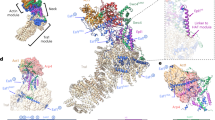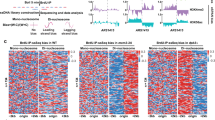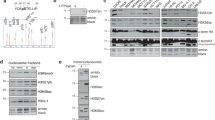Abstract
Acetylation within the globular core domain of histone H3 on lysine 56 (H3K56) has recently been shown to have a critical role in packaging DNA into chromatin following DNA replication and repair in budding yeast1,2. However, the function or occurrence of this specific histone mark has not been studied in multicellular eukaryotes, mainly because the Rtt109 enzyme that is known to mediate acetylation of H3K56 (H3K56ac) is fungal-specific3,4. Here we demonstrate that the histone acetyl transferase CBP (also known as Nejire) in flies and CBP and p300 (Ep300) in humans acetylate H3K56, whereas Drosophila Sir2 and human SIRT1 and SIRT2 deacetylate H3K56ac. The histone chaperones ASF1A in humans and Asf1 in Drosophila are required for acetylation of H3K56 in vivo, whereas the histone chaperone CAF-1 (chromatin assembly factor 1) in humans and Caf1 in Drosophila are required for the incorporation of histones bearing this mark into chromatin. We show that, in response to DNA damage, histones bearing acetylated K56 are assembled into chromatin in Drosophila and human cells, forming foci that colocalize with sites of DNA repair. Furthermore, acetylation of H3K56 is increased in multiple types of cancer, correlating with increased levels of ASF1A in these tumours. Our identification of multiple proteins regulating the levels of H3K56 acetylation in metazoans will allow future studies of this critical and unique histone modification that couples chromatin assembly to DNA synthesis, cell proliferation and cancer.
This is a preview of subscription content, access via your institution
Access options
Subscribe to this journal
Receive 51 print issues and online access
$199.00 per year
only $3.90 per issue
Buy this article
- Purchase on SpringerLink
- Instant access to full article PDF
Prices may be subject to local taxes which are calculated during checkout




Similar content being viewed by others
References
Chen, C. C. et al. Acetylated lysine 56 on histone H3 drives chromatin assembly after repair and signals for the completion of repair. Cell 134, 231–243 (2008)
Li, Q. et al. Acetylation of histone H3 lysine 56 regulates replication-coupled nucleosome assembly. Cell 134, 244–255 (2008)
Han, J. et al. Rtt109 acetylates histone H3 lysine 56 and functions in DNA replication. Science 315, 653–655 (2007)
Xhemalce, B. et al. Regulation of histone H3 lysine 56 acetylation in Schizosaccharomyces pombe . J. Biol. Chem. 282, 15040–15047 (2007)
Williams, S. K., Truong, D. & Tyler, J. K. Acetylation in the globular core of histone H3 on lysine-56 promotes chromatin disassembly during transcriptional activation. Proc. Natl Acad. Sci. USA 105, 9000–9005 (2008)
Xu, F., Zhang, K. & Grunstein, M. Acetylation in histone H3 globular domain regulates gene expression in yeast. Cell 121, 375–385 (2005)
Schneider, J., Bajwa, P., Johnson, F. C., Bhaumik, S. R. & Shilatifard, A. Rtt109 is required for proper H3K56 acetylation: a chromatin mark associated with the elongating RNA polymerase II. J. Biol. Chem. 281, 37270–37274 (2006)
Recht, J. et al. Histone chaperone Asf1 is required for histone H3 lysine 56 acetylation, a modification associated with S phase in mitosis and meiosis. Proc. Natl Acad. Sci. USA 103, 6988–6993 (2006)
Masumoto, H., Hawke, D., Kobayashi, R. & Verreault, A. A role for cell-cycle-regulated histone H3 lysine 56 acetylation in the DNA damage response. Nature 436, 294–298 (2005)
Tang, Y. et al. Fungal Rtt109 histone acetyltransferase is an unexpected structural homolog of metazoan p300/CBP. Nature Struct. Mol. Biol. 15, 738–745 (2008)
Liu, X. et al. The structural basis of protein acetylation by the p300/CBP transcriptional coactivator. Nature 451, 846–850 (2008)
Florence, B. & McGinnis, W. A genetic screen of the Drosophila X chromosome for mutations that modify Deformed function. Genetics 150, 1497–1511 (1998)
Marcu, M. G. et al. Curcumin is an inhibitor of p300 histone acetylatransferase. Med. Chem. 2, 169–174 (2006)
Carre, C., Szymczak, D., Pidoux, J. & Antoniewski, C. The histone H3 acetylase dGcn5 is a key player in Drosophila melanogaster metamorphosis. Mol. Cell. Biol. 25, 8228–8238 (2005)
Celic, I. et al. The sirtuins Hst3 and Hst4p preserve genome integrity by controlling histone H3 lysine 56 deacetylation. Curr. Biol. 16, 1280–1289 (2006)
Maas, N. L., Miller, K. M., DeFazio, L. G. & Toczyski, D. P. Cell cycle and checkpoint regulation of histone H3 K56 acetylation by Hst3 and Hst4. Mol. Cell 23, 109–119 (2006)
Francis, N. J. & Kingston, R. E. Mechanisms of transcriptional memory. Nature Rev. Mol. Cell Biol. 2, 409–421 (2001)
Garcia, B. A. et al. Organismal differences in post-translational modifications in histones H3 and H4. J. Biol. Chem. 282, 7641–7655 (2007)
Tsubota, T. et al. Histone H3–K56 acetylation is catalyzed by histone chaperone-dependent complexes. Mol. Cell 25, 703–712 (2007)
Tamburini, B. A., Carson, J. J., Adkins, M. W. & Tyler, J. K. Functional conservation and specialization among eukaryotic anti-silencing function 1 histone chaperones. Eukaryot. Cell 4, 1583–1590 (2005)
Scholzen, T. & Gerdes, J. The Ki-67 protein: from the known and the unknown. J. Cell. Physiol. 182, 311–322 (2000)
Groth, A. et al. Human Asf1 regulates the flow of S phase histones during replicational stress. Mol. Cell 17, 301–311 (2005)
Schulz, L. L. & Tyler, J. K. The histone chaperone ASF1 localizes to active DNA replication forks to mediate efficient DNA replication. FASEB J. 20, 488–490 (2006)
Sanematsu, F. et al. Asf1 is required for viability and chromatin assembly during DNA replication in vertebrate cells. J. Biol. Chem. 281, 13817–13827 (2006)
Ait-Si-Ali, S. et al. CBP/p300 histone acetyl-transferase activity is important for the G1/S transition. Oncogene 19, 2430–2437 (2000)
Yao, T. P. et al. Gene dosage-dependent embryonic development and proliferation defects in mice lacking the transcriptional integrator p300. Cell 93, 361–372 (1998)
Hasan, S., Hassa, P. O., Imhof, R. & Hottiger, M. O. Transcription coactivator p300 binds PCNA and may have a role in DNA repair synthesis. Nature 410, 387–391 (2001)
Ait-Si-Ali, S. et al. Histone acetyltransferase activity of CBP is controlled by cycle-dependent kinases and oncoprotein E1A. Nature 396, 184–186 (1998)
Meshorer, E. et al. Hyperdynamic plasticity of chromatin proteins in pluripotent embryonic stem cells. Dev. Cell 10, 105–116 (2006)
Shechter, D., Dormann, H. L., Allis, C. D. & Hake, S. B. Extraction, purification and analysis of histones. Nature Protocols 2, 1445–1457 (2007)
Tyler, J. K. et al. The RCAF complex mediates chromatin assembly during DNA replication and repair. Nature 402, 555–560 (1999)
Tyler, J. K. et al. Interaction between the Drosophila CAF-1 and ASF1 chromatin assembly factors. Mol. Biol. Cell 21, 6574–6584 (2001)
Frei, C. & Gasser, S. M. The yeast Sgs1p helicase acts upstream of Rad53p in the DNA replication checkpoint and colocalizes with Rad53p in S-phase-specific foci. Genes Dev. 14, 81–96 (2000)
Pallier, C. et al. Association of chromatin proteins high mobility group box (HMGB) 1 and HMGB2 with mitotic chromosomes. Mol. Biol. Cell 14, 3414–3426 (2003)
Madigan, J. P., Chotkowski, H. L. & Glaser, R. L. DNA double-strand break-induced phosphorylation of Drosophila histone variant H2Av helps prevent radiation-induced apoptosis. Nucleic Acids Res. 30, 3698–3705 (2002)
Hoek, M. & Stillman, B. Chromatin assembly factor 1 is essential and couples chromatin assembly to DNA replication in vivo . Proc. Natl Acad. Sci. USA 100, 12183–12188 (2003)
Kim, E. J., Kho, J. H., Kang, M. R. & Um, S. J. Active regulator of SIRT1 cooperates with SIRT1 and facilitates suppression of p53 activity. Mol. Cell 28, 277–290 (2007)
Megiorni, F., Indovina, P., Mora, B. & Mazzilli, M. C. Minor expression of fascin-1 gene (FSCN1) in NTera2 cells depleted of CREB-binding protein. Neurosci. Lett. 381, 169–174 (2005)
Kuninger, D. et al. Gene disruption by regulated short interfering RNA expression, using a two-adenovirus system. Hum. Gene Ther. 15, 1287–1292 (2004)
Rosenfeld, J., Capdevielle, J., Guillemot, J. C. & Ferrara, P. In-gel digestion of proteins for internal sequence analysis after one- or two-dimensional gel electrophoresis. Anal. Biochem. 203, 173–179 (1992)
Hellman, U., Wernstedt, C., Gonez, J. & Heldin, C. H. Improvement of an “In-Gel” digestion procedure for the micropreparation of internal protein fragments for amino acid sequencing. Anal. Biochem. 224, 451–455 (1995)
Acknowledgements
We thank J. Kadonaga for Drosophila embryos and the Sir2 antibody, A. Mazo for the CBP antisera, and E. Nigg for ASF1A/B antisera. We thank C. Wike and the UC microscope core, and the UCCC flow cytometry core for assistance. This work was supported by funding from the National Institutes of Health (grants GM64475 and CA95641) to J.K.T.
Author Contributions C.D. performed all the experiments, and devised some of the experiments. K.H. performed all the mass spectrometry analyses, M.S.L. performed all the pathology and immunohistochemistry analyses, J.K.T. and C.D. wrote the manuscript and J.K.T. guided the research.
Author information
Authors and Affiliations
Corresponding author
Supplementary information
Supplementary Information
This file contains Supplementary Table 1, Supplementary Figures 1-18 with Legends and Supplementary References. (PDF 5645 kb)
Rights and permissions
About this article
Cite this article
Das, C., Lucia, M., Hansen, K. et al. CBP/p300-mediated acetylation of histone H3 on lysine 56. Nature 459, 113–117 (2009). https://doi.org/10.1038/nature07861
Received:
Accepted:
Published:
Issue Date:
DOI: https://doi.org/10.1038/nature07861
This article is cited by
-
Impact of NAD+ metabolism on ovarian aging
Immunity & Ageing (2023)
-
Experimental analysis of bladder cancer-associated mutations in EP300 identifies EP300-R1627W as a driver mutation
Molecular Medicine (2023)
-
Epigenetic mechanisms to propagate histone acetylation by p300/CBP
Nature Communications (2023)
-
Oncogenic signaling-mediated regulation of chromatin during tumorigenesis
Cancer and Metastasis Reviews (2023)
-
Histone chaperone ASF1A accelerates chronic myeloid leukemia blast crisis by activating Notch signaling
Cell Death & Disease (2022)



